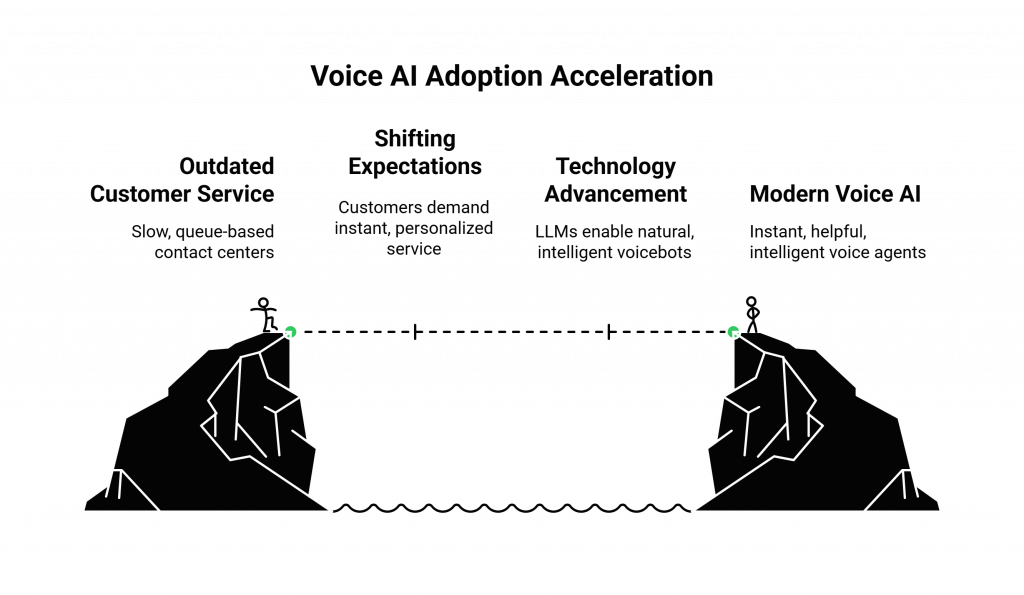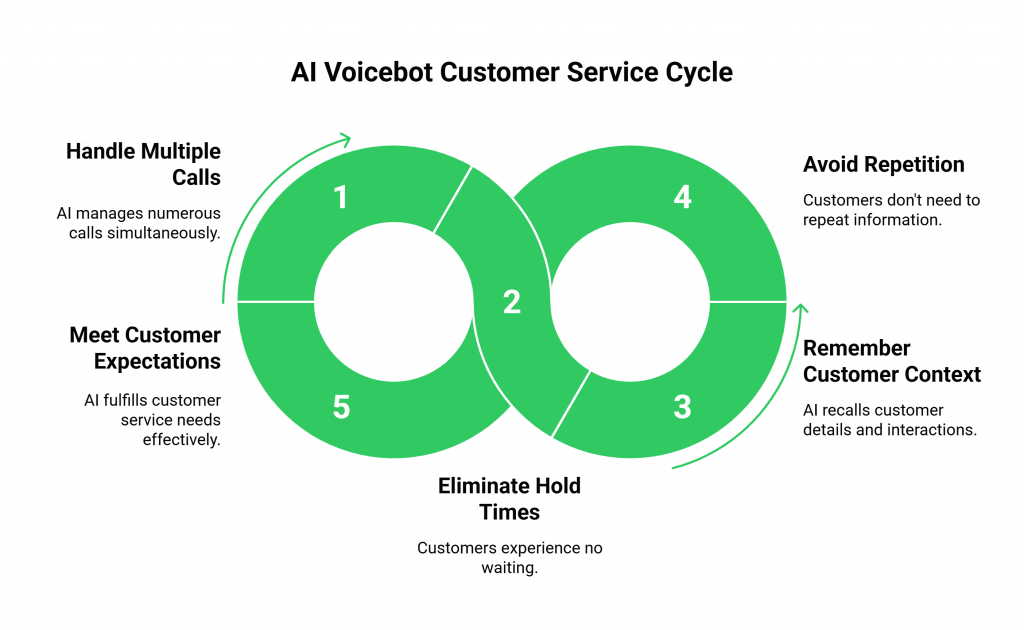The sound of hold music is the sound of a business failing its customers. It’s a universal symbol of friction, a sign that a customer’s valuable time is being wasted while they wait in a queue to ask a simple question. For decades, this has been the accepted, unavoidable reality of customer service.
But a fundamental shift is underway, a technological transformation that is making hold music, and the inefficient system it represents, obsolete.
This transformation is being driven by the modern AI voicebot. This is not the robotic, frustrating phone menu of the past. This is a new generation of intelligent, conversational agents that can understand, reason, and resolve issues with a level of speed and efficiency that was once unimaginable.
The move towards the AI voicebot is not a fleeting trend; it is a strategic business imperative. It’s a response to a perfect storm of evolving customer expectations and maturing AI technology.
This guide will explore the powerful, multifaceted “why” behind this shift, breaking down the core economic, experiential, and strategic drivers that are compelling businesses of all sizes to embrace the future of voice automation.
Table of contents
Why is This Shift Happening Right Now?
The sudden acceleration in the adoption of voice AI is not an accident. It’s the result of two powerful forces converging at the perfect moment.

First, customer expectations have fundamentally changed. The on-demand, instant-gratification world of digital apps has reshaped what we consider “good” service. We expect instant answers, 24/7 availability, and personalized experiences.
A recent HubSpot report found that a staggering 90% of customers rate an “immediate” response as important or very important when they have a customer service question. The traditional, 9-to-5, queue-based contact center is a relic that simply cannot meet this modern demand.
Second, the technology has finally caught up to the ambition. The rise of powerful, accessible Large Language Models (LLMs) has been the catalyst.
These are the “brains” that allow an AI voicebot to move beyond rigid scripts and have truly natural, context-aware conversations. This technological leap has made it possible to build voice agents that are not just functional, but genuinely helpful and intelligent.
Also Read: How To Create AI Chatbot Voice Functions Using Real-Time APIs?
How Do AI Voicebots Drive Economic Value?
The most immediate and compelling reason for the shift is the powerful economic case. An AI voicebot is not a cost center; it’s a powerful engine for both cost reduction and revenue generation.
How Do They Drastically Reduce Operational Costs?
The primary economic benefit comes from “call deflection”, the ability of the AI to fully resolve a customer’s issue without ever needing to involve a more expensive human agent. The cost difference is dramatic.
A 2022 report from Gartner found that a single live agent interaction can cost a company between $8 and $13, whereas a fully automated interaction can cost less than a dollar.
An AI voicebot achieves this by becoming a 24/7 expert on your most frequent and repetitive inquiries. By automating these high-volume, low-complexity calls, it can have an immediate and significant impact on your operational budget.
How Do They Unlock New Revenue Opportunities?
Beyond cost savings, an intelligent voice agent is a proactive revenue generator.
- 24/7 Lead Capture: Every call that reaches voicemail after hours risks losing a lead forever. An AI voice bot ensures every inbound inquiry is answer, anytime, day or night. It can qualify new leads, answer their initial questions, and even book them directly into a salesperson’s calendar, plugging a massive hole in the sales funnel.
- Automated Upselling and Cross-selling: During a routine service call, the AI can be programmed to identify opportunities. For example, after helping a customer track an order for a new camera, it might say, “I see you didn’t order a case for your new camera. Customers who bought this model often find our padded carrying case very helpful. Can I add one to your order?”
How Does an AI Voicebot Create a Superior Customer Experience?
A business that competes on experience wins. The shift to an AI voicebot is a strategic move to eliminate the most common sources of customer frustration and create an experience that is fast, personal, and effortless.
How Does It Eliminate the Biggest Frustrations: Waiting and Repetition?
An AI voicebot directly attacks the two most hated parts of any customer service call.

- It Eliminates Hold Times: A human agent can only handle one call at a time, which creates queues. An AI, built on a scalable cloud infrastructure, can handle tens of thousands of calls simultaneously. For the customer, this means there is effectively no queue.
- It Eliminates Repetition: A modern AI voicebot is built with “contextual memory.” It remembers who the customer is and what they’ve already said. This is in stark contrast to the experience of being transferred between human agents. A recent Salesforce report on the connected customer found that a remarkable 71% of customers expect companies to share information internally so they don’t have to repeat themselves. An AI with a perfect memory is designed to meet this expectation flawlessly.
Also Read: How To Add Chatbot Voice Assistant Capabilities in Your Backend?
How Does It Enable Hyper-Personalization at Scale?
By integrating with your CRM, a voice AI can have conversations that are deeply personalize. It knows the customer’s name, their purchase history, and their previous support interactions. This allows it to move beyond generic scripts and create a tailored experience, such as greeting a returning customer with, “Welcome back, Sarah. Are you calling about the order you placed last week?” This level of personal recognition makes customers feel valued and understood.
The entire experience hinges on a powerful, real-time voice infrastructure. A platform like FreJun AI provides the ultra-low-latency streaming and deep API control necessary to fetch this CRM data and generate a personalized response in the fraction of a second needed for a natural conversation.
Ready to see how an AI voicebot can transform your customer engagement? Sign up for a FreJun AI Today!
Conclusion
The business world’s shift to the AI voicebot is not a matter of “if,” but “when.” The forces of customer expectation and technological capability have created an undeniable imperative for change. This is a rare moment in business where a single technology can simultaneously create a trifecta of benefits: a dramatic reduction in costs, a significant improvement in the customer experience, and a more empowered and efficient human workforce.
By embracing this human-AI partnership, businesses can move beyond the frustrating, inefficient models of the past and build a customer communication engine that is intelligent, scalable, and ready for the future.
Want to understand the infrastructure that powers a truly intelligent contact center? Schedule a Demo for FreJun Teler!
Also Read: Outbound Call Center Software: Essential Features, Benefits, and Top Providers
Frequently Asked Questions (FAQs)
An AI voicebot is a conversational AI that uses a voice interface to communicate with users. It leverages technologies like Speech-to-Text, a Large Language Model (LLM), and Text-to-Speech to have natural, human-like conversations to perform tasks or provide information over the phone.
There is an initial investment in development. However, the operational cost of an AI voicebot is much lower than a human agent. The return on investment is high, driven by cost savings from call deflection and increased revenue from 24/7 availability.
The goal is augmentation, not replacement. An AI voice bot handles high-volume, repetitive tasks, freeing your skilled human agents to focus on complex, emotional, and high-value customer interactions where their expertise matters most.
The timeline varies. You can build a simple AI voice bot to answer basic FAQs in a few weeks, while more complex bots that integrate deeply with multiple business systems take longer.
Yes. With modern, high-quality Text-to-Speech (TTS) engines and a well-written, conversational script, an AI voicebot can sound remarkably human-like, with natural intonation and an empathetic tone.
Security is a critical design consideration. A secure AI voice bot runs on encrypted voice infrastructure, redacts sensitive data from logs, and uses secure methods like DTMF (keypad tones) to process payment information safely.
For a small business, the main benefit is the ability to offer 24/7 availability and capture every single lead without the high cost of round-the-clock staffing. It levels the playing field with larger competitors.
A model-agnostic platform, like FreJun AI, is not tied to a specific AI provider. It gives you the freedom to choose your own “best-of-breed” STT, LLM, and TTS models. This allows you to build a powerful and cost-effective solution.
